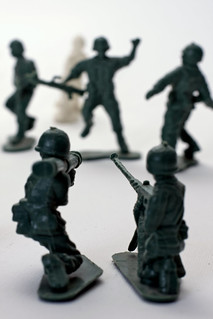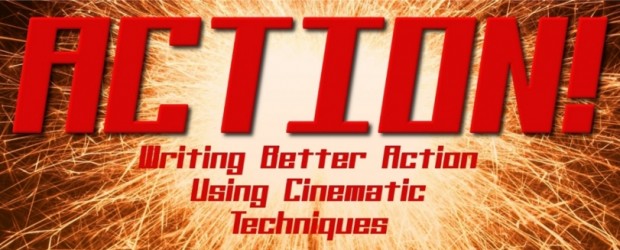Stephen Gustav is writing an epic contemporary fantasy/military mashup called The Veil War, and posting chapters as he completes them. His latest chapter had a really tremendous pitched battle scene between two large armies, and I thought he wrote it very well. I asked him to break it down for you all here, so read and enjoy! Although you should probably read the story from the beginning, if you would like to read the chapter that really stood out for me, it’s here. Take it away, Stephen…
One day it occurred to me that folks were writing a lot of fantasy mashups. Paranormal Romance by the truck load. Urban fantasy combining film noir and magic. Police procedurals with wizards. Charles Stross’ Laundry series mixing Lovecraft, spy novels and UNIX geeks.
Wait – no one had done Tom Clancy techno-thriller meets fantasy? Something must be done!
Step one, daydream a lot. What would happen if the dark hordes invaded the Earth? First approximation: they’d get blown up from a great distance. Start over…
The Veil War is goblins invading the Earth. Giants, dragons, trolls – creatures of myth that turn out to be a little less imaginary than we had supposed. Magic had existed once, and now has returned. And in the Middle East, a company of Marines is trying desperately to get home.
Our Story So Far
Over the course of twenty-four chapters, Captain Lewis and his Marines manage to make some progress toward this goal despite all I do to hinder them. They’ve fought their way out of Iraq. They’ve met and allied with the descendants of crusaders, whose own world is threatened. Lewis quickly comes to realize that the knowledge these crusaders possess is crucial to our survival.
The enemy is coming after them, and in great force. As they approach Kuwait they find that between them and their pursuers is a Heavy Cavalry Brigade Combat Team – a few thousand Idaho National Guardsmen who are about to be ground into paste by the enemy. This turn of events presented Lewis with two options:
* Run behind and let the cav get ground up to hamburger. Maybe escape, maybe get caught anyway.
* Intervene now, and combine the strength of his magical new allies with the firepower of an armored brigade to inflict defeat upon the enemy.
Lewis chooses the latter.
From about Chapter 19 to present, that battle is ongoing – and will continue for several more chapters at a minimum.
What is this ‘Process’ you speak of?
I find myself mildly embarrassed to discuss “process” or “craft” in relation to my own work. Not that I don’t sort of have a process and certainly not that I don’t believe that there is a craft of writing that I hope one day to have.
But I am new to this whole writing thing. Sort of. I’ve been writing for decades, and I even get paid for my writing. Yet the Veil War is the first fiction story I have ever run to even the moderate level of completion that I’ve achieved here.
So, that out of the way, what was I doing here? Well, something very different than what I was doing in the first eight chapters. The first eight chapters I had actually imagined in a rather thoroughgoing way before ever I laid finger on keyboard. So that was really like dictation.
As the story moved on beyond the little movie I had made in my head, things immediately became more difficult. But I soldiered on; and with a few brutal reminders sound editing advice from Ian managed to tame the story and get it focused to the point where we could get to the next big action sequence.
What’s a Day Job?
So is there a process? Thanks to a cruel and uncaring universe, writing the Veil War is not my day job. That miserable fact imposes certain constraints on how I go about getting it written.
Last winter, I took a week off from work so that I could get some serious writing done. Everything from about chapter thirteen on, I wrote that week. Or at least I wrote the original version that week. I wrote as fast as I could, being as visual and descriptive as I could. My goal was simply and always to get as much written as possible.
Since then, every week I read the chapter before, read what’s next in the queue, and then attempt to figure out how I need to change the text to fit what’s happened already and how my picture of the plot has altered. There’s a lot of clean-up, too. Like places in the text where I’d inserted <> or <> in order to keep the story moving. It’s hardest when I hit a <> as that usually means writing and thinking.
Sometimes it is as simple as rearranging a couple things, a few tweaks, some polishing and, presto DONE! But not as often as I’d hope.
If in the greener lands of the future I am a professional novelist, I don’t know that I’d write a novel this way. There are advantages though: it forces me to treat every chapter on its own merits. (And if it doesn’t have any, repair that.) I can’t just skip ahead to the interesting bits. It also forces me to cut and pare away the dross, so what’s left is better – I think – than if I’d just written the whole thing in seclusion.
The biggest benefit is feedback. The input from my weekly readers has been essential, and I don’t think it will be easy to move away from that.
How Sausage Is Made
There’s a lot going on in this battle. There are four distinct sides: Lewis and his men, The Prince and his crusaders, the Cavalry Brigade, and the enemy. Lots of that last. Not being content with such a simplistic layout, I divided the crusaders in two. And among the enemy there are many regiments of goblins. Plus trolls. Plus giants. Plus a dragon. And, starting next chapter, even more.
All of this needs to be coordinated. First, in my head; and then I have to relate all that to the reader. I have to be mindful of the pacing and build tension in how I flip from one aspect of the battle to another.
I’ve tried to treat each scene as a short story of sorts – I’m not just cutting away at a random word length or just to get back to something else. I try to have each one come to some sort of climax or at least a plausible cliffhanger before I move on to the next.
For example in this chapter I begin with Odo, the crusader second in command. I’d left the readers hanging for quite a while as he charged toward the giants – a good cliffhanger. That needed to be resolved, so I tackled that first before moving to the next scene.
As the battle has gotten more complex, I find I’m diverging more from what I wrote back in February. For the last few chapters, my process has changed from editing to something more like construction. To manage the complexity, I’ve assembled a timeline. Each faction has his own thread – a sequence of events that they personally encounter.
When I assemble a chapter, I dip into the timeline to see what has to happen. Then I dip from the pot of prose to get story that covers the need. The shape of the battle is different from what I originally imagined – but strangely a lot of the individual events in it are much like what I’ve already written.
There’s a few things that I try to keep in mind as I write, whittle and edit. One thing Ian impressed upon my fragile brain last Spring was, “Does this move the story forward?” If it doesn’t, it goes no matter how much I like it. Another I learned from Tom Clancy, in an inverse way. Don’t have everything go right for your heroes. My final rule is, “Try not to suck.” That’s the hardest one.
One of the biggest struggles I’ve had writing this battle is that it is not happening to Lewis. Corporal Coleman is essential, because he’s a kind of a geek chorus. He says what needs to be said because most of what I’m doing is actually describing someone watching someone else fight. Which makes sense in the context of choosing Lewis for my point of view, but otherwise is completely retarded.
The one saving grace is that it offers a reasonable means of offering commentary on what is happening. It’s a frame for describing the events of the battle. This will change shortly, as the battle is coming to Lewis – and that will present different challenges.


